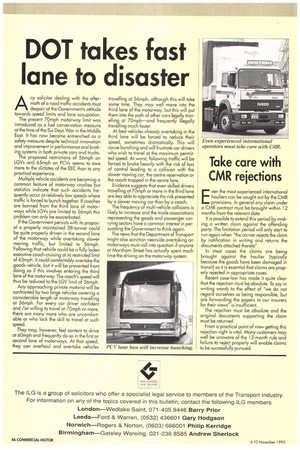DOT takes fast lane to disaster
Page 48

If you've noticed an error in this article please click here to report it so we can fix it.
Any solicitor dealing with the aftermath of a road traffic accidents must despair at the Government's attitude towards speed limits and lane occupation.
The present 70mph motorway limit was introduced as a Fuel conservation measure at the time of the Six Days War in the Middle East. It has now become entrenched as a safety measure despite technical innovation and improvement in performance and braking systems in both private cars and trucks. The proposed restrictions of 56mph on LGVs and 65mph on PCVs seems to owe more to the dictates of the EEC than to any practical experience. Multiple vehicle accidents are becoming a common feature of motorway crashes but statistics indicate that such accidents frequently occur at relatively low speeds where traffic is forced to bunch together. If coaches are banned from the third lane of motorways while LGVs are limited to 56mph this problem can only be exacerbated. If the Government persists with its proposal a properly maintained 38-tonner could be quite properly driven in the second lane of the motorway while overtaking slower moving traffic, but limited to 56mph. Following that vehicle could be a fully laden executive coach cruising at its restricted limit of 65mph. It could comfortably overtake the goods vehicle, but it will be prevented from doing so if this involves entering the third lane of the motorway. The coach's speed will thus be reduced to the LGV limit of 56mph. Any approaching private motorist will be confronted by Iwo large vehicles covering a considerable length of motorway travelling at 56mph. For every car driver confident and /or willing to travel at 70mph or more, there are many more who are uncomfortable or who lack the skill to travel at such speed. They may, however, feel content to drive at 60mph and frequently do so in the first or second lane of motorways. At that speed, they can overhaul and overtake vehicles travelling at 56mph, although this will take some time. They may well move into the third lane of the motorway, but this will put them into the path of other cars legally travelling at 70mph—and frequently illegally travelling much faster. At best vehicles already overtaking in the third lane will be forced to reduce their speed, sometimes dramatically. This will cause bunching and will frustrate car drivers who wish to travel at the maximum permitted speed. At worst, following traffic will be forced to brake heavily with the risk of loss of control leading to a collision with the slower moving car, the centre reservation or the coach trapped in the centre lane. Evidence suggests that even skilled drivers travelling at 70mph or more in the third lane are less able to appreciate the risk presented by a slower moving car than by a coach. The frequency of multi-vehicle collisions is likely to increase and the trade associations representing the goods and passenger carrying sectors have a common interest in persuading the Government to think again. The news that the Department of Transport might also sanction nearside overtaking on motorways must call into question if anyone at Marsham Street has actually spent much time the driving on the motorway system.




























































































